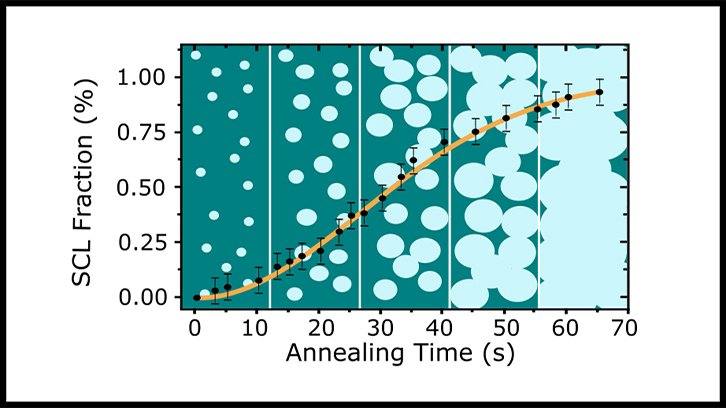Melting of ultrastable glasses

The transition from glass to liquid, due to an increase of temperature, causes changes in the dynamic properties of matter, such as viscosity, without changing its structure. Although different theories try to explain this phenomenon, according to the Materials Physics I Unit of the UAB, focused on the ultrastable glasses, the transformation mechanism resembles a melting process that initiates in nanoscopic regions of lower density already existing in the glass.
The glass transition, the passage from a mobile liquid to a highly viscous glass as temperature decreases, remains one of the enigmas of condensed matter physics after more than 100 years of intensive research from different fields of physics, chemistry and/or physical chemistry. It is surprising that a disordered material, with no atomic or molecular order even at short distances, exhibits such an abrupt change in its dynamic properties, in a reduced temperature range, in which the structure remains practically undisturbed. This exponential change of the dynamic properties without changes in the microstructure continues to amaze and disturb the scientific community dedicated to the study of the glass state.
Nowadays there are contradictory theories that try to explain the glass transition: some consider that after the kinetic arrest that is observed experimentally during quenching there is a thermodynamic phase transition, but inaccessible in the laboratory. Other theories maintain that the vitreous state corresponds to a supercooled liquid of high viscosity and that nothing differentiates the two states. In general, it is accepted that the glass transition observed in the laboratory, which is manifested by a relatively abrupt jump in the heating capacity when the temperature varies, is a kinetic transition, since the temperature at which it occurs, i.e. the glass transition temperature, depends on the thermal history of the material. In a general context, the phenomenology of the glass transition can be applied to processes in which the time scales on which some physical magnitude is equilibrated become longer than the time scale on which the system is observed.
In an article recently published in Physical Review Letters, researchers from the Materials Physics I Unit of the Department of Physics at the Universitat Autònoma de Barcelona show that the transformation mechanism of ultra-stable glasses resembles a first-order transformation and can be described within the framework of the classical theory of nucleation and growth.
In this work, researchers at the UAB use special glasses called ultra-stable glasses. These materials, grown in a few minutes from the vapor, have surprising properties, such as high thermodynamic stability or density, comparable to those that could be achieved by a glass obtained from the liquid and stabilized for thousands or millions of years. The transformation has been analyzed using nanocalorimetry, a technique that gives access to the calorific capacity of ultrafine layers and in which the UAB group is a pioneer at international level. From the analysis of the specific heat capacity the fraction of glass transformed into a liquid phase as a function of time at temperatures above the glass transition temperature is extracted. The evolution of the transformed fraction is used to determine the transformation mechanism.
Surprisingly, the transformation resembles a conventional melting process dominated by an heterogeneous nucleation at pre-existing sites which, in absence of experimental confirmation, are speculated to be low density nanoscopic regions already existing in the glass. This discovery is of vital importance to extend the phenomenology of the glass transition and to try to elucidate its true nature. In a more applied aspect, this research is relevant to be able to manufacture more durable and efficient electronic devices, such as OLEDs (Organic Light Emitting Devices).
Materials Physics I.
Area of Applied Physics.
Universitat Autònoma de Barcelona (UAB).
References
A. Vila-Costa, J. Ràfols-Ribé, M. González-Silveira, A. F. Lopeandia, Ll. Abad-Muñoz, and J. Rodríguez-Viejo. Nucleation and Growth of the Supercooled Liquid Phase Control Glass Transition in Bulk Ultrastable Glasses. (2020) Phys. Rev. Lett. 124 (7), 076002. DOI:10.1103/PhysRevLett.124.076002


